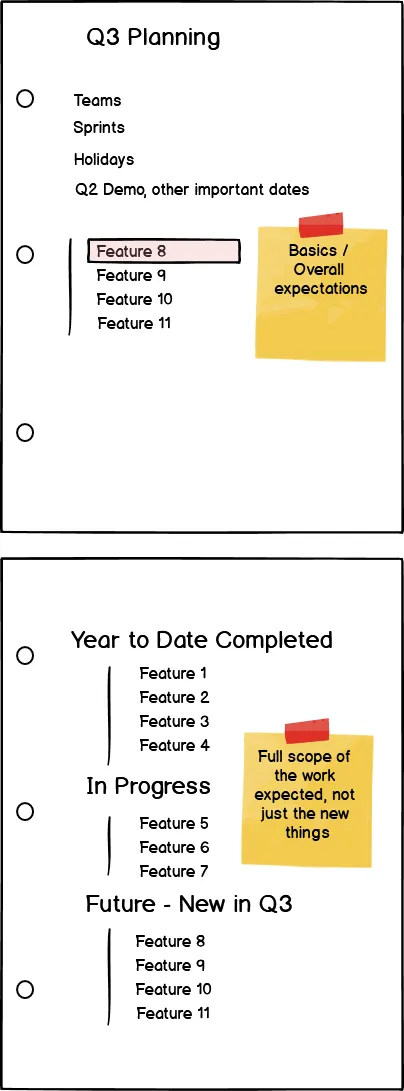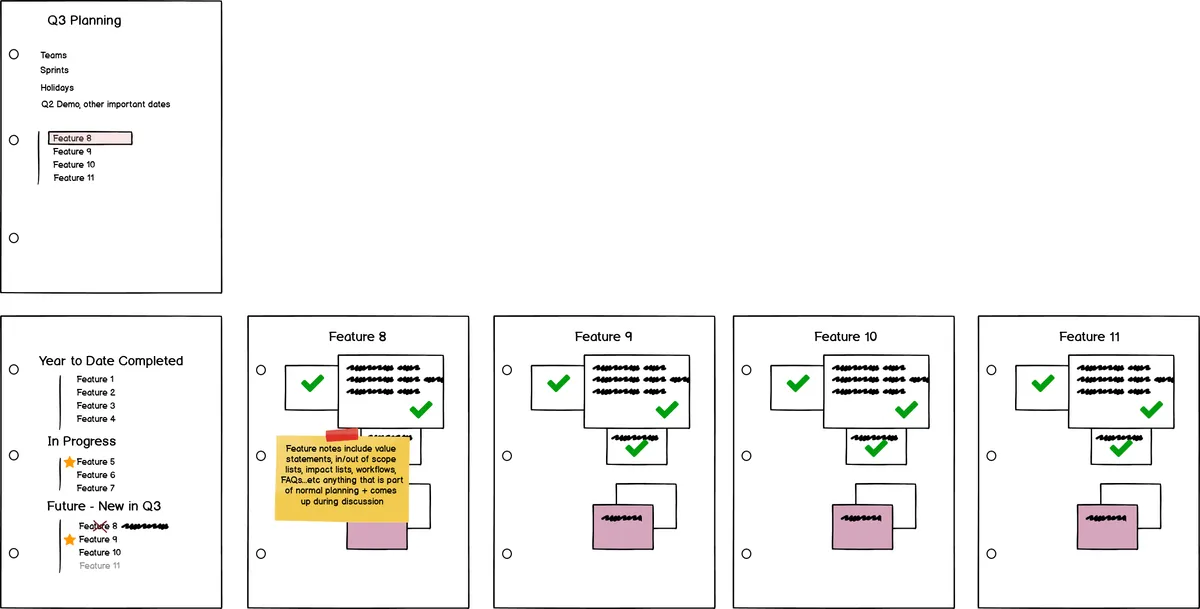Cultivate buy-in during planning
where to start
Snacks and seating arrangements. In college I took a certification course for how to talk about work processes- back then there was a lot of emphasis on how to be transparent in the right way, show good intentions with snacks, and where to seat everyone around the projector. It was lovely. These days though, where everyone is comfortably placed behind their own monitor, the snacks and seats don't matter as much, but proper transparency matters more than ever. Over the years I've developed a specific style of planning that serves me well, and adding it to my work library here. Effective planning starts with where the team was before, and is now, before charting a path forward.
Unfortunately too many planning sessions, in my experience, ignore the past for a straightforward reason: the past is over now and the timeline cannot be changed. Fair enough, but here’s the kicker - everyone on the team lived through it, worked very hard on it, and created a shared experience together in that same aforementioned past. The rest of this post will detail how to plan with teams properly, so that at the end of planning the team agrees on what needs to be done.
Planning does not have to be so grueling; in fact it can be insightful and energizing, but throwing a bunch of people in a meeting and expecting them to work out longstanding structural problems is a recipe for frustration. Good planning facilitators will bring information together in a new way to guide discussion, anticipate the flow of information needed to get from point a: unplanned to point b: planned.
Spending effort to align on where 'a', or the starting flag, is posted, as well as 'b', the finish line, is worth the investment. The planning facilitator must get the team to align on both how and where to start with the project in order for any chance of success. Initial alignment entails acknowledging the basics:
- who is on the team, their history with the company, specialties
- where is this project in the grand scheme of all other projects, who from leadership is expecting this and when
- what do we know about the project so far, in terms of approvals, tools, any new systems or processes we must use
- what was the most recent project that was similar to this, and how that one turned out
Get these answered, agreed upon, and written down first. Too many times I’ve seen these types of grounding questions glossed over in favor of trying to force untangling the problem. When that happens, the project discussion sidelines - conversations like "why plan for X feature when we don’t even know who will be on the team?" Or "why are we doing this now, when Y is still in flux?" These are valid concerns and when unaddressed, the buy-in meter goes down. Notice these questions also have nothing to do with the project that needs planning, and everything to do with the context around it - these questions are a great way to get distracted. State these basic assumptions upfront so everyone can use it as a foundation to plan. Write them down (reminder #2 for documentation).
Fill buy-in meter step 1: Establish the basics in writing. This allows the team to come to a collective agreement on something right away, setting the foundation for further agreement.
Now we can start to create boundaries around this work.
outline
A good outline is one that everyone agrees on. It is also one that charts progress at the right level of detail. These progress checkpoints allow for flexibility, demonstrating a few different ways of getting from start to finish. The example listed here is for a Quarterly Planning for a theoretical upcoming Q3. This specific outline looks like groupings of tasks YTD (year to date) completed, in progress, and then future. Surfacing this past work allows the planning team to make associations between the work that has already been done and the work that will be done. It’s easier to identify risks and roadblocks this way, and see where we might be able to speed up or reuse work that has already been figured out.
The key to this one is getting all of the work on the table so there are more chances for associations, and the mental load can be anticipated week to week.

This structure keeps individual work items in the larger context of how it all fits together, and completing these rolls up to a higher level outcome.
Looking at it this way allows me to put together big picture themes and make sure higher level targets are being met. This is an amazing time to bring in goals of other teams as well, just ask if there are other initiatives flying around that may not be going through the normal channels, but that could impact any of this work. At the end of the day different managers are pulling different levers for what gets done and when, and it’s in my best interest to see to all of their success as well. Ultimately I want to be extra transparent about priorities, and the amount of work that different groups are expecting to complete within the planning timeframe.
Taking care of my own success criteria, I automatically build them into the in-scope items, and try not to be annoying about it when I ask about goals on other teams, and if they take the opening to collaborate, all the better. If not, I just move the planning train along.
filling in the outline together
A good planning should sound like:
- “while we’re thinking about all of this, does (Name of Very Opinionated Stakeholder) want us to do anything specific for Reporting, or for the Home Page - should I put an item in here or does this look good enough for now”
- “How did we solve X in the past, was that a new standard or just a one-off?”
- “Good idea, that can be in scope as part of Y for now”
- “Good thinking, this needs to be listed as out of scope for Y for now”
- “In theory, could we start X tomorrow, or what else do we need first?” 1
The planning discussion itself should also look like moving things out of scope, and in scope, and double checking everyone’s assumptions for the scope items in the upcoming quarter. The team probably has some things on their mind that should be accounted for - I like to do this on the call while sharing my screen so that people can physically see things getting added to lists and moved around. This helps individuals too who may have a huge risk, and need to see that it is addressed properly before they can take in any new information or look at the bigger picture. The elusive ‘alignment’ we are all after, this is how it happens.
Updating scope, writing everyone's thoughts down, while sharing my screen so they can see it happening and where it will be stored later is hugely strategic for a few reasons, not the least of which is improving buy-in.2
Fill buy-in meter step 2: Write down and incorporate everyone's feedback during the meeting on the plan itself, underneath the plan, in the notes of the work items, wherever it makes sense. We want to reward participation, collect viewpoints and questions, and it is only in this way can we create a shared vision of what the end goal will look like.
Also, frankly, it is a waste of time for everyone to take individual notes, as a facilitator a deliverable for the meeting is to provide one set of notes, in a shared place, that everyone can reference at a later time. I have incredibly strong, verging on unreasonably strong, feelings on this. For the purpose of this planning session, the resulting map acts as an artifact of the meeting and should be accompanied only by a light set of notes.
PRO TIP I like to put stars next to the showcase items, the big ones that will demo extra well. Mostly because its fun for me, but also so the team knows that I will be asking about these more than the others, and preparing demos and otherwise promoting these starred items to stakeholders and management.

By now the team should have a clearer picture in their minds on what the next quarter will look like.
ready
At the end of it all, these plannings should end up with a high level outline and details about each item included. about what the next few months will look like, and it’s so much easier to visualize the path forward with the following:
- what the end goal/success looks and feels like
- where we are not going just as much as where we plan to go
- in context of where we’ve been
That’ll do for me for now so thank you for reading & take care of yourself, gently please.
Made with <3 not AI.
................................................
................................................
latest posts here:
This question has saved me more times than I can count, especially on new teams, especially in places where some people need secret approval from stakeholders that should not matter but do, especially when there are webs of secret approvals that need to happen in order for any actual work to progress publicly. For those of you that viscerally relate to this - this is a leadership problem, not a you problem, and you are not alone. Just ask the team “what else do we need to start X if we were going to start tomorrow” and hope that someone will tell you whose explicit or implicit approval you need to get, and how it was gotten in the past. Then document it for yourself and try not to think about it too much…there is only pain here.↩
I attended a planning session once where the facilitator made a comment along the lines of "thank you for that comment, now could you please get that documented properly and reach out to the affected colleagues". Not wanting to seem like an assistant, or a meeting scribe, had the opposite effect of the stated meeting goal - which included calling out impacts. This reverse uno didn't lessen the impacts of the project, in fact it dis-incentivized anyone else from speaking up; as a team member they would have to do this work anyway. As a facilitator, unless otherwise dictated at the start of the meeting, it absolutely is is this person's responsibility to take notes, and it is certainly not to delegate work. We are seeking information to build a map, and when an expert in their area of the map surfaces a river to cross or a mountain to climb, it is important enough to write down.↩